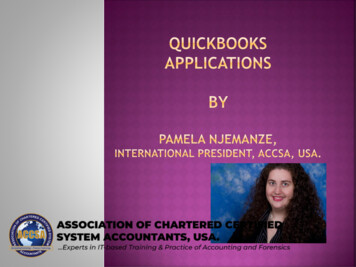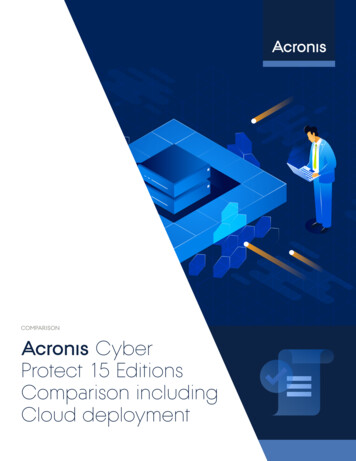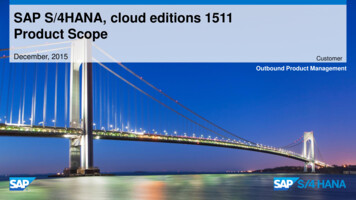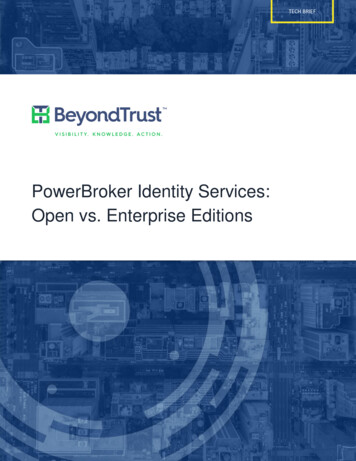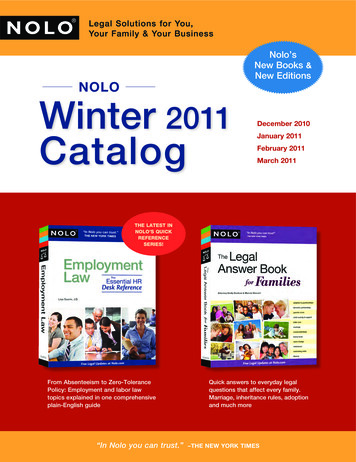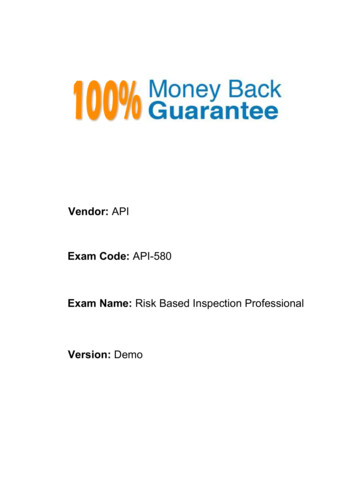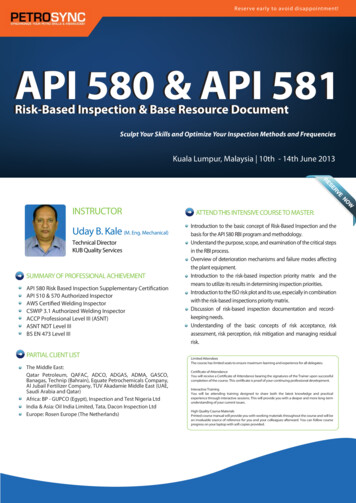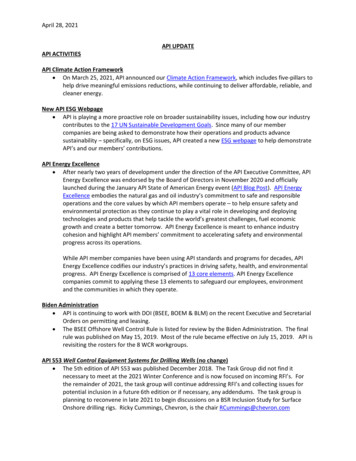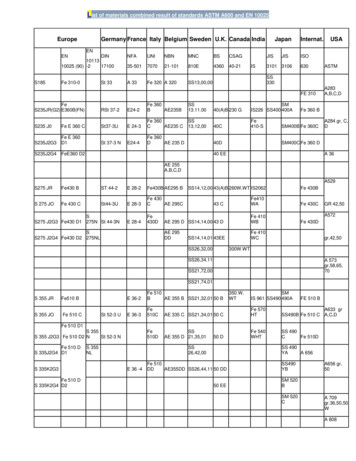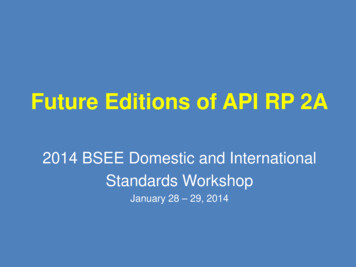
Transcription
Future Editions of API RP 2A2014 BSEE Domestic and InternationalStandards WorkshopJanuary 28 – 29, 2014
Future Editions of API RP 2A API RP 2A-WSD 22nd Edition Based on OTC 23558, “Insights into Using the 22ndEdition of API 2A” by K. A. Digre and F. J. Zwerneman API RP 2A-LRFD 2nd Edition (tentative title)Modified adoption of ISO 19902, “Fixed Steel OffshoreStructures”
RP 2A 22nd - API TG 13Mike Abbas – Foster Wheeler UpstreamFrank Buescher – Braemar CasbarianKris Digre – API ConsultantAbdel Ghoneim – AtkinsRudy Hall – Keystone EngineeringRalph Shaw – Keystone EngineeringGwen Accardo – Keystone EngineeringJay Hooper – BPHyungwoo Kim - ShellDavid Stockard - FluorBoon Sze Tan – ConocoPhillipsBen Chang – J. Ray McDermott EngFarrel Zwerneman – Wood Group Mustang
API RP 2A-WSD 22nd EditionBackgroundDocument OrganizationDocument ContentClarificationSummary
Background API Standards are scheduled to be reviewed and revised,reaffirmed, or withdrawn at least every five years Incorporate content from API Bulletins 2INT-MET, 2INTDG, 2INT-EX Accommodate development of API RP 2SIM, 2MET, 2EQ,2GEO, 2MOP Needed technical revisions Editorial cleaning
Background (cont’d) Formed Task Group in October 2007 Decided RP 2A would not follow the organization of ISO19902 Moved MET content to 2MET, 2EQ, while retaininginformation required for structural design Followed “API Document Formatting and Style Manual” International System (SI) as primary units / U.S.Customary as secondary units
API RP 2A-WSD 22nd EditionBackgroundDocument OrganizationDocument ContentClarificationSummary
Organization1.2.3.4.5.6.7.8.9.10.Introduction, Purpose and Scope (new)References (new)Definitions and Acronyms (new)Planning (21st Section 1)Design Criteria and Procedures (21st Section 2)Structural Steel Design (21st Section 3)Strength of Tubular Joints (21st Section 4)Fatigue (21st Section 5)Foundation Design (21st Section 6)Other Structural Components and Systems (21stSection 7)
Organization (cont’d)11.12.13.14.15.16.17.18.19.Material (21st Section 8)Drawings and Specifications (21st Section 9)Welding (21st Section 10)Fabrication (21st Section 11)Installation (21st Section 12)Inspection (21st Section 13)Accidental Loading (21st Section 18)Reuse (21st Section 15)Minimum and Special Structures (21st Section 16)
Organization (cont’d) Annex A: 21st Edition Cross Reference to 22nd EditionFigures, Tables, and Equations Annex B – Commentary Bibliography
Organization (cont’d) Parts of 21st Edition Section 2 moved to 2MET Appropriate parts of 21st Edition Section 9 moved to 2GEO All portions of 21st Edition Sections 14 (Surveys) and 17(Assessment of Existing Platforms) have been moved to2SIM Parts of 21st Edition Section 18 (Fire, Blast, and AccidentalLoading) are now in 2FB
API RP 2A-WSD 22nd EditionBackgroundDocument OrganizationDocument ContentClarificationSummary
ContentSpecial attention regarding the following non-API normative references: AISC Specification for Structural Steel Buildings , 1989 in 9th editionmanual (Allowable Strength Design) LRFD methods are based on calibration with building designpractices and may not be applicable to offshore platforms Work in progress to incorporate provisions of the new AISCspecification into offshore design practices AWS D1.1/D.1.1M:2010 Structural Welding Code – Steel. Referenceto a specific D1.1 edition (exceptions are already included in 2A)protects against possible future conflicting modifications.
Content (cont’d)Table 4.1 — Exposure Category MatrixConsequence CategoryLife Safety CategoryC-1, High ConsequenceC-2, Medium ConsequenceC-3, Low ConsequenceS-1 manned-nonevacuatedL-1aL-1aL-1aS-2 manned-evacuatedL-1L-2L-2S-3 unmannedL-1L-2L-3a Manned-nonevacuated platforms are presently not applicable to the U.S. GoM waters where platforms are normally evacuated ahead of hurricane events. Themetocean design criteria in Section 5 have not been verified as adequate for manned-nonevacuated in the U.S. GoM. However, the winter storm, sudden hurricaneand earthquake criteria for the U.S. GoM have been verified as adequate for the manned-nonevacuated situation occurring during those events when platforms inthe U.S. GoM waters are not normally evacuated.
Content (cont’d)Table 5.5 — Design Level Criteria and Robustness AnalysisExposureCategoryDesign Level CriteriaRobustness Level Ultimate Strength AnalysisL-1aUse the 100 year full population and associated conditionsfrom API 2MET or site-specific data developed in accordancewith the requirements of API 2METUse the 1,000 year full population wave and associated conditionsfrom API 2MET or site-specific data developed in accordance withthe requirements of API 2METL-2Use the 50 year full population and associated conditionsfrom API 2MET or site-specific data developed in accordancewith the requirements of API 2METNot required if L-2 exposure category platform has a robustconfigurationL-3Use the 25 year full population and associated conditionsfrom API 2MET or site-specific data developed in accordancewith the requirements of API 2METFor non-robust configurations – Use the 500 year full populationwave and associated conditions from API 2MET or site-specificdata developed in accordance with the requirements of API 2METNot requiredaManned-nonevacuated platforms are presently not applicable to the U.S. GoM waters where platforms are normally evacuated ahead of hurricane events. The metocean design criteria in Section 5 havenot been verified as adequate for manned-nonevacuated in the U.S. GoM. However, the winter storm, sudden hurricane and earthquake criteria for the U.S. GoM have been verified as adequate for themanned-nonevacuated situation occurring during those events when platforms in the U.S. GoM waters are not normally evacuated
Content (cont’d)Minimum Deck Clearance- New L-1 and L-2 platforms in the Gulf of Mexico:“The elevation for the underside of the deck shall not be lowerthan the 1000-year return period maximum crest height elevationprovided in API 2MET or site-specific data developed inaccordance with the requirements of API 2MET.”
Content (cont’d)Minimum Deck Clearance cont.- New L-3 platforms in the Gulf of Mexico:“The deck may be located below the 1000-year return periodcrest elevation only if the entire topsides are located belowthe calculated crest elevation of the design wavedesignated for L-3 Structures. In this case, the full wave andcurrent forces on the deck topsides shall be considered.”“However, if the deck is located above the crest elevation ofthe L-3 wave, then the deck shall be located above thecalculated crest elevation of the wave designated for the L1 structures.”
API RP 2A-WSD 22nd EditionBackgroundDocument OrganizationDocument ContentClarificationSummary
ClarificationJoint Design rules requiring a minimum capacity toaccommodate 50% of any effective member strength havebeen clarified and made more specific:“Chords at the ends of tension and compression braces, inaddition to developing the strength required by design loads,shall also have a minimum capacity of at least 50 % of theeffective strength of each incoming brace for each designload condition (in-place, loadout, lifting, launch, accidental,etc.).”
Clarification (cont’d)Joint failure prior to a brace failure is undesirable50 % minimum chord capacity requirement is intended to: improve relative reliability of joints and members increase platform robustness provide a safety net for unanticipated loads such assupport failure during loadout, unexpected weatherconditions during launch or lifting, vessel collisions anddropped objects ensure minimum capacity for connections of secondarymembers that take on primary importance in reservestrength assessments
Clarification (cont’d)For full advantage during reserve strength assessments,effective strength of brace should include effects ofstrengthening for: corrosion allowance section availability design events other than the one under consideration
Clarification (cont’d)Non-critical joints may be excluded from minimum capacityrequirement. A joint may be considered non-critical only if itsfailure: would not reduce reserve strength of structure for designevent being considered would not reduce capacity of structure to withstandaccidental loads would not have significant safety or environmentalconsequences
API RP 2A-WSD 22nd EditionBackgroundDocument OrganizationDocument ContentClarificationSummary
Summary RP 2A has been significantly revised for the 22nd Editionin terms of both organization and content, but the contentretained in the 22nd edition has not been significantlychanged when used with API 2MET, 2GEO, 2EQ, 2SIM,2FB and 2MOP. RP 2A 22nd Edition has passed through revision, balloting,revision, recirculation, revision, editorial review andrevision, and page proof revision. Publication is expectedin ? quarter of 2014.
Future Editions of API RP 2A API RP 2A-WSD 22nd Edition Based on OTC 23558, “Insights into Using the 22ndEdition of API 2A” by K. A. Digre and F. J. Zwerneman API RP 2A-LRFD 2nd Edition (tentative title)Modified adoption of ISO 19902, “Fixed Steel OffshoreStructures”
API TG 19Moises Abraham - ChevronCarlos Llorente – McDermottBala Balakrishnan – Amec (London)Andrea Mangiavacchi - ExperiaRichard Beck - BPNigel Nichols1 - PetronasRodney Deschamps - ChevronShashikant Sarada - DNVMichael Effenberger – StressRalph Shaw – Keystone1Michael Efthymiou - ShellBoon Sze Tan - ConocoPhillipsSteve Gunzelman – BechtelPao-Lin Tan – ABS TechnologyJay Hooper - BPPaul Taylor - ExxonMobilParvinder Jhita – Bentley (EDI)Liangsheng Wang – AtkinsAlbert Ku – EnergoAdel Younan -XOMTommy Laurendine – LibertyBob Zhang - TechnipFarrel Zwerneman - Mustang1corresponding member
High Level Summary Modified adoption involves– Detailed Review of ISO 19902 by TG– Prepare draft under API cover with proposedmodifications– Review and ballot by SC2 Deliver ready-to-ballot draft by Mar/31/2014– Achieve LRFD capability in API ASAP– Close alignment with ISO
Modifications Pile foundation section in LRFD 2nd edition– Capacity equations pointing to API 2GEO– Resistance factors to be the same as ISO 19902 Shallow foundation section in LRFD 2nd edition– Capacity equations pointing to API 2GEO– Resistance factors from UT research will be reviewedby 2GEO TG and provided to LRFD TG
Modifications (cont’d) Other than foundation section– Load factors from API RP 2A-LRFD 1st Edition will beused– Retain API 50% minimum joint requirement– Difference in conical transition results to beinvestigated– Difference in hydrostatic effect to be investigated– Metocean criteria modified to match RP 2A-WSD 22ndedition– Overlap with 2SIM and 2MOP resolved
API 2TOP API 2TOP will be ready-for-ballot also by Mar/31/2014– Modified adoption of ISO 19901-3
ISO 19902 Status Next revision of 19902 on 2016/2017 Albert Ku participating in ISO 19902 committee (partialfactors & members/joints panels) Moises Abraham participating in API TG19 TG19 action items shared with ISO 19902
Concluding Remarks TG19 currently working hard to have a ready-to-ballotdraft by Mar/31/2014 Work underway to compare ISO 19902 results to 2AWSD results for several platforms
API RP 2A-WSD 22nd Edition . Content . Special attention regarding the following non- API normative references : AISC pecification for Structural Steel BuildingsS, 1989 in 9th edition manual (Allowable Strength Design) LRFD ethods are based on calibration with building design m practices and may not be applicable to offshore platforms Work n progress to incorporate provisions of the new i .File Size: 293KBPage Count: 34People also search forapi rp 2aapi rp 2a free downloadapi rp 6aapi methodCode of Practice for Fixed Offshore Struct API RP2A drage coefficient
![API Ballot: [Ballot ID] – API 510 & API 570, Deferrals, Rev05](/img/5/api510andapi570deferralsrev5.jpg)
